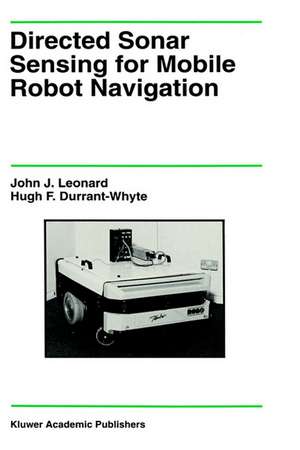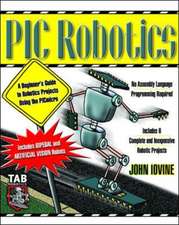Directed Sonar Sensing for Mobile Robot Navigation: The Springer International Series in Engineering and Computer Science, cartea 175
Autor John J. Leonard, Hugh F. Durrant-Whyteen Limba Engleză Hardback – 31 mai 1992
| Toate formatele și edițiile | Preț | Express |
|---|---|---|
| Paperback (1) | 940.39 lei 6-8 săpt. | |
| Springer Us – 8 oct 2012 | 940.39 lei 6-8 săpt. | |
| Hardback (1) | 948.61 lei 6-8 săpt. | |
| Springer Us – 31 mai 1992 | 948.61 lei 6-8 săpt. |
Din seria The Springer International Series in Engineering and Computer Science
- 24%
 Preț: 1041.97 lei
Preț: 1041.97 lei - 20%
 Preț: 643.50 lei
Preț: 643.50 lei - 18%
 Preț: 1225.62 lei
Preț: 1225.62 lei - 18%
 Preț: 965.02 lei
Preț: 965.02 lei - 20%
 Preț: 646.12 lei
Preț: 646.12 lei - 18%
 Preț: 948.79 lei
Preț: 948.79 lei - 20%
 Preț: 646.62 lei
Preț: 646.62 lei - 15%
 Preț: 637.46 lei
Preț: 637.46 lei - 20%
 Preț: 643.83 lei
Preț: 643.83 lei - 18%
 Preț: 949.23 lei
Preț: 949.23 lei - 20%
 Preț: 644.48 lei
Preț: 644.48 lei - 20%
 Preț: 994.92 lei
Preț: 994.92 lei - 20%
 Preț: 645.97 lei
Preț: 645.97 lei - 18%
 Preț: 946.87 lei
Preț: 946.87 lei - 20%
 Preț: 995.57 lei
Preț: 995.57 lei - 18%
 Preț: 956.99 lei
Preț: 956.99 lei - 20%
 Preț: 644.98 lei
Preț: 644.98 lei - 15%
 Preț: 649.54 lei
Preț: 649.54 lei - 18%
 Preț: 950.21 lei
Preț: 950.21 lei - 18%
 Preț: 1221.38 lei
Preț: 1221.38 lei - 18%
 Preț: 957.62 lei
Preț: 957.62 lei - 15%
 Preț: 643.99 lei
Preț: 643.99 lei - 18%
 Preț: 948.47 lei
Preț: 948.47 lei - 18%
 Preț: 947.35 lei
Preț: 947.35 lei - 20%
 Preț: 1284.65 lei
Preț: 1284.65 lei - 20%
 Preț: 1633.95 lei
Preț: 1633.95 lei - 20%
 Preț: 1285.78 lei
Preț: 1285.78 lei
Preț: 948.61 lei
Preț vechi: 1156.84 lei
-18% Nou
Puncte Express: 1423
Preț estimativ în valută:
181.52€ • 187.26$ • 151.48£
181.52€ • 187.26$ • 151.48£
Carte tipărită la comandă
Livrare economică 26 martie-09 aprilie
Preluare comenzi: 021 569.72.76
Specificații
ISBN-13: 9780792392422
ISBN-10: 0792392426
Pagini: 183
Ilustrații: XXI, 183 p.
Dimensiuni: 155 x 235 x 17 mm
Greutate: 0.54 kg
Ediția:1992
Editura: Springer Us
Colecția Springer
Seria The Springer International Series in Engineering and Computer Science
Locul publicării:New York, NY, United States
ISBN-10: 0792392426
Pagini: 183
Ilustrații: XXI, 183 p.
Dimensiuni: 155 x 235 x 17 mm
Greutate: 0.54 kg
Ediția:1992
Editura: Springer Us
Colecția Springer
Seria The Springer International Series in Engineering and Computer Science
Locul publicării:New York, NY, United States
Public țintă
ResearchCuprins
Preface.- 1 Introduction.- 1.1 The Navigation Problem.- 1.2 Why Use Sonar?.- 1.3 Choosing a Representation.- 1.4 The Kalman Filter.- 1.5 Data Association.- 1.6 Overview.- 2 A Sonar Sensor Model.- 2.1 Introduction.- 2.2 Previous Work.- 2.3 Terminology.- 2.4 The Physics of Sonar.- 2.5 Predicting Sonar Data.- 2.6 Theory vs Practice.- 2.7 Regions of Constant Depth.- 2.8 Sparse vs Densely Sampled Data.- 2.9 Discussion.- 2.10 Summary.- 3 Model-based Localization.- 3.1 Introduction.- 3.2 Problem Statement.- 3.3 The Basic Localization Cycle.- 3.4 Algorithm Summary.- 3.5 Off-line Processing of Densely Sampled Data.- 3.6 Sparse Data Error Model.- 3.7 Tracking Planar Targets.- 3.8 Tracking Planes, Corners, and Cylinders.- 3.9 Hands-off Localization Results.- 3.10 Discussion.- 3.11 Alternative Approaches.- 3.12 Summary.- 4 Map Building.- 4.1 Introduction.- 4.2 Specular Event Interpretation.- 4.3 Rules for RCD-based Sonar Interpretation.- 4.4 Map Building via Track Initiation.- 4.5 Experimental Results.- 4.6 Multiple Hypothesis Track Initiation.- 4.7 Alternative Approaches.- 4.8 Why Build Accurate Maps?.- 5 Simultaneous Map Building and Localization.- 5.1 A Unified Approach to Navigation.- 5.2 Research Issues.- 5.3 Restatement of the problem.- 5.4 A Strategy for Decoupling A(k I k).- 5.5 Initialization With Sonar.- 5.6 Dynamic Map Building and Maintenance.- 5.7 Summary.- 6 Directed Sensing Strategies.- 6.1 The Time Problem.- 6.2 Tracking Sonars.- 6.3 Orienteering.- 6.4 Related Research: Sensor Control.- 6.5 Summary.- 7 Why Use Sonar?.- 7.1 Sonar vs the Infrared Rangefinder.- 7.2 Sonar vs Vision.- 7.3 Sensor Fusion.- 7.4 Future Research.- 7.5 Contributions.- A Hardware and Software.- A.1 Mobile Robots.- A.2 The Polaroid Ultrasonic Ranging System.- A.3 Software.











